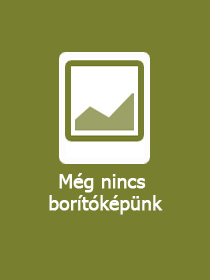
Routledge Handbook of Smart Built Environment
-
10% KEDVEZMÉNY?
- A kedvezmény csak az 'Értesítés a kedvenc témákról' hírlevelünk címzettjeinek rendeléseire érvényes.
- Kiadói listaár GBP 165.00
-
83 506 Ft (79 530 Ft + 5% áfa)
Az ár azért becsült, mert a rendelés pillanatában nem lehet pontosan tudni, hogy a beérkezéskor milyen lesz a forint árfolyama az adott termék eredeti devizájához képest. Ha a forint romlana, kissé többet, ha javulna, kissé kevesebbet kell majd fizetnie.
- Kedvezmény(ek) 10% (cc. 8 351 Ft off)
- Discounted price 75 156 Ft (71 577 Ft + 5% áfa)
83 506 Ft

Beszerezhetőség
Becsült beszerzési idő: A Prosperónál jelenleg nincsen raktáron, de a kiadónál igen. Beszerzés kb. 3-5 hét..
A Prosperónál jelenleg nincsen raktáron.
Why don't you give exact delivery time?
A beszerzés időigényét az eddigi tapasztalatokra alapozva adjuk meg. Azért becsült, mert a terméket külföldről hozzuk be, így a kiadó kiszolgálásának pillanatnyi gyorsaságától is függ. A megadottnál gyorsabb és lassabb szállítás is elképzelhető, de mindent megteszünk, hogy Ön a lehető leghamarabb jusson hozzá a termékhez.
A termék adatai:
- Kiadás sorszáma 1
- Kiadó Routledge
- Megjelenés dátuma 2025. március 20.
- ISBN 9781032462080
- Kötéstípus Keménykötés
- Terjedelem360 oldal
- Méret 246x174 mm
- Súly 830 g
- Nyelv angol
- Illusztrációk 10 Illustrations, black & white; 65 Illustrations, color; 65 Halftones, color; 10 Line drawings, black & white 697
Kategóriák
Rövid leírás:
The primary aim of this edited volume is to document the current theories, best practices, and technological advancements in the move towards a Smart Built Environment (SBE).
TöbbHosszú leírás:
The primary aim of this edited volume is to document the current theories, best practices, and technological advancements in the move towards a Smart Built Environment (SBE). The needs to accelerate towards the SBE are numerous and include:
- Increasing complexities and the need for interconnectivity within the built environment (e.g. mega infrastructure projects)
- Data-driven decision-making resulting in higher demand from clients (e.g. smart design, construction, operation, and end of life [EOL])
- High requirements from stakeholders (e.g. system efficiency, environmental performance, green procurement)
- Fast paced technological advancement and integration
- Natural disaster resilience of the built environment (e.g. prediction, smart control of building component)
- Sustainability issues around the built environment
In this book, the interrelationships among the various lifecycle stages: design, construction, operation, and EOL; the collective benefit of synergy at building level, multi-infrastructure level, and city-level, as well as the ultimate goals in relation to the deployment of smart technologies in the industry are addressed. Part I covers smart design and construction, Part II smart living, and operation, and Part III broadens the scope to the whole smart city. Chapters examine:
- How smart technologies can improve the effectiveness, productivity, and efficiency of the built environment
- An overview of theories and practices that are enabled by innovations and technologies for developing the SBE
- The basis for new research agenda, new concepts, and frameworks for future development
This handbook documents the current theories, practices, and technologies and develops a holistic approach for research and practice by adopting a multidimensional outlook for the SBE. It is an essential reference work for all built environment stakeholders, from academia through to the professions.
TöbbTartalomjegyzék:
Foreword by Faye Bowser
Introduction
Chapter 1: Digital twins for smart decision making
Chapter 2: From particles to spaces: The intelligent planning unit (IPU) theory to simplify the built environment
Chapter 3: Generative design for excellence (DfX) for a smart built environment: From rule-based imitation to data-driven exploration
Chapter 4: Project Delivery Methods to Digital Fabrication in Architecture: A Comparative Case Study from a Modularity Perspective
Chapter 5: Unlocking the power of language models for smart configuration in the AEC domain using spoken language understanding
Chapter 6: Physical fatigue assessment (PFA) for construction workers with AI and sensory techniques
Chapter 7: Smart or not? Perspectives on digital fabrication and digital construction
Chapter 8: Methodical review of exoskeleton use in the construction industry
Chapter 9: Ontological Models for Construction Scheduling and Resource Planning
Chapter 11: A Theoretical Framework for Integrating Digital Twins in Building Lifecycle Management
Chapter 12: Digital Twin-Based Prototype System for Healthcare Facilities Management
Chapter 13: Activity-Based Models for Smart and Sustainable Urban Environment
Chapter 14: Sustainable Urban Built Environment: Principles, Tools, and Applications
Chapter 15: Exploring the Potentials and Obstacles of City Information Modelling
Chapter 16: Mobility-as-a-Service (MaaS) and the Built Environment
Chapter 17: Integrated Smart Curb Management in Urban Built Environments Addressing Human Dynamics and Disruptive Technologies
Chapter 18?Digital technologies for climate-adaptive smart urban transportation systems
Chapter 19: Blockchain for Smart Built Environment: Current Status, Challenges, and Prospects
Chapter 20: Effects of Signage Color on Human Psychophysiological States and Wayfinding Performance in Urban Underground Spaces with Different Noise Levels: A Combined EEG and VR Experiment
Conclusion
Több







